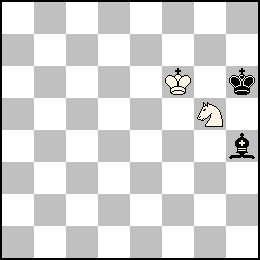
Exemple (en orthodoxe) - Example (orthodox) |
|
| Coups blancs possibles : White possibles moves : |
Re5, Rf5, Re6, Rg6, Re7, Rf7, Rg7, Ch3, Cf3, Ce4, Ce6, Cf7, Ch7 |
| Coups blancs légaux : White legal moves : |
Re5, Rf5, Re6, Re7, Rf7 |
| Coups noirs possibles : Black possible moves : |
Rh5, R×g5, Rg6, Rg7, Rh7, F×g5+, Fg3, Ff2, Fe1 |
| Coups noirs légaux : Black legal moves : |
Rh5, Rh7, F×g5+, Fg3, Ff2, Fe1 |